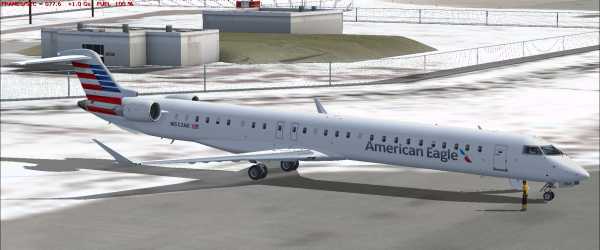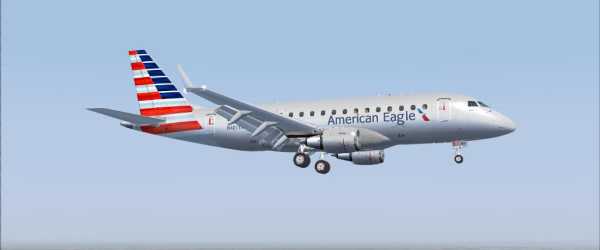American Eagle S Fsx Planes
Contents.History Prior to the in 1978, most major US air carriers had maintained close relationships with independent regional carriers in order to feed passengers from smaller markets into the larger cities, and, in turn, onto the larger legacy carriers. In the post-regulation era, the hub-and-spoke system gained prominence, and in order to feed traffic from smaller markets into these newly established hubs, the major carriers outsourced regional operations to these smaller carriers. These relationships included the use of, shared, and listing regional partners in the computer reservations systems of the mainline carrier.American Eagle commenced service on November 1, 1984 with a flight from Fayetteville, Arkansas to (DFW).
This flight was operated by (a wholly owned subsidiary of ), using a turboprop aircraft. Metroflight also operated commuter turboprop aircraft on American Eagle flights serving DFW. Other operators contracted by to fly the American Eagle banner during this time included, Air Virginia (later AV Air), Chaparral Airlines, and.On September 15, 1986, joined the American Eagle system.
American Eagle ERJ-145 FSX #11517581. BY mossfan15 - Thu Feb 17, 2011 2:08 am - Thu Feb 17, 2011 2:08 am #11517581. I recently purchased the ERJ 135/145 series from Wilco. Does anyone know where I can get the American Eagle re paint? How about for the CRJ program from wilco? Thanks in advance. SRA Michael Mays, USAF.
With hub operations at in, the addition of Executive Airways to the American Eagle family opened up an extensive inter-island network throughout the.Between 1987 and 1989 AMR Corp. (parent corporation of American Airlines) gradually acquired most of its regional carriers, starting with Simmons Airlines. By 1991, AMR had consolidated its wholly owned regional carriers into four separate entities:,. AMR would later purchase the assets of bankrupt in 1993. At this point, AMR owned all of the airlines that were operating for American Eagle.On May 15, 1998, and were merged into, with the new entity given the name.
Along with Executive Airlines, these would be the only two operators using the American Eagle brand name for the next fourteen years.After acquired in 2001, it retained the contracts with the carriers that operated under the banner, which, at the time, included,. However, instead of being integrated into the American Eagle brand, these carriers operated under a separate regional brand known as. This brand name was used for thirteen years before being discontinued in 2014.2010s developments As part of its restructuring and emergence from chapter 11 bankruptcy, AMR announced that it would start contracting American Eagle flying to carriers outside of its wholly owned subsidiaries. On November 15, 2012, and, both subsidiaries of began operations for American Eagle. On August 1, 2013, a subsidiary of, commenced flying operations under the American Eagle branding as part of a 12-year capacity purchase agreement to operate aircraft for American Eagle.On September 12, 2012 AMR announced the discontinuation of the AmericanConnection brand, and all operations were going to be integrated into the American Eagle brand. However, a subsidiary of and the only operator of American Connection flights at the time of the announcement, opted not to renew its contract.
All AmericanConnection flights ended on August 19, 2014.American Eagle service operated by ceased operations on March 31, 2013. At the same time, its base at San Juan was dehubbed.Due to the fact that an increasing number of other carriers were being contracted to fly under the American Eagle brand, it was announced on January 15, 2014 that American Eagle Airlines would change its name to. The name change took effect on April 15, 2014., a subsidiary of, began American Eagle operations on March 27, 2015, as part of a deal to operate 20 new aircraft on behalf of American. These aircraft are based at American's Los Angeles hub.had announced it would exclusively fly as United Express which commenced in March 2018, ending their involvement in operating flights under the American Eagle brand.In May 2018, American Airlines announced the termination of its partnerships with ExpressJet and Trans States Airlines as of 2019, meaning the end of those operators conducting American Eagle flights.
Operators and fleet. An American Eagle ERJ145 on approach to BWI.As of August 2019, the combined American Eagle branded fleet consists of the following regional jet aircraft:American EagleAirlineIATA ServiceICAO CodeCallsignAircraftIn fleetOrdersPassengersParentFY +YTotalCPCPZCompass6MQENYEnvoy486550——44446015——204476YVASHAir Shuttle64—9—12—6779PTPDTPiedmont60——5050OHJIABlue Streak34——276YXRPABrickyard6OOSKWSkyWest5870Total62755Former operators AirlineYears of operationNotes1985–1988Assets acquired by AMR and integrated into Nashville Eagle.2005–2018Originally flew as. A formerly operated by American Eagle at Los Angeles International Airport. (2007)The American Eagle brand, through its various regional and commuter airline partners, operated a variety of twin turboprop aircraft over the years including the following types:. and 32 models. (stretched G-IC model)., a regional carrier wholly owned by American Airlines Group, and acquired through the merger with, was operating a fleet of (formerly ) turboprops for the regional brand.
These aircraft had already been rebranded as American Eagle since the merger process is now fully complete.Destinations. Main article: Accidents and incidents. May 8, 1987:, operated by regional airline, a, was on a domestically scheduled passenger flight between - when it crashed short of Runway 09 while landing at Mayaguez. After impacting, the plane continued through a chain-link fence and a ditch.
Of the six occupants onboard (four passengers and two crew), two were killed. The cause of the crash was determined to be improper maintenance in setting the flight idle propeller and engine fuel flow. February 19, 1988:, a operated by AVAir, was on a regularly scheduled flight between - when it crashed into a reservoir about a mile from, from where it had departed, in the vicinity of. The aircraft departed during low-ceiling, low-visibility, and night conditions.
Analysis of radar data indicated the aircraft was in a 45-degree descending turn. Both crew members and all 10 passengers were killed. June 7, 1992:, operated by regional airline, was on a regular flight between and when it lost control and crashed nose-down about 3/4 mile from the airport. Both crew and all three passengers were killed. The aircraft involved was a. October 31, 1994:, an operated by AMR's regional airline, crashed near Roselawn, Indiana. The aircraft inverted, dived, and crashed from a holding pattern at 10,000 feet (3050 m) 'after a ridge of ice accreted beyond the deice boots' resulting in an unexpected aileron hinge moment reversal that subsequently resulted in the loss of control.
The four crew and 64 passengers were all killed. In the months following the accident, American Eagle redeployed its ATR fleet to Miami and the Caribbean where icing is not an issue. The aircraft manufacturer, ATR, has since improved the anti-ice boots. The American Eagle aircraft were modified with the updated deicing system.

Fsx New Planes
All ATR 72s were retired from American Eagle's fleet in 2013. December 13, 1994:, operated by AMR's regional airline, a, was on a regularly scheduled - service when it crashed into a wooded area about four miles southwest of the in the vicinity of. Of the 20 onboard (18 passengers and two crewmembers) 15 were killed while the five survivors received serious injuries. The probable cause of the crash was the pilot not following proper procedure in an engine-failure situation. July 9, 1995: American Eagle Flight 4127, an operated by, experienced a loss of the rear cabin entry door during its climb after taking off from in. The cabin door opened shortly after the first officer began to pressurize the cabin; therefore, only a slight pressure differential existed between the cabin pressure and the atmospheric pressure. Lack of damage indicates the door was unlocked/unlatched when it opened.
The airplane was one of fifteen aircraft equipped with a new handrail and door handle design which was different than the majority of the fleet. The old handle was pulled down to latch/lock the door and pushed up to unlatch/unlock the door.
The direction of motion was reversed so that the handle was pushed up to latch/lock the door and pulled down to unlatch/unlock the door. A private citizen located the separated door in approximately two feet of water in the Des Plaines River on July 10, 1995. Following this incident, ATR designed another new door handle design which returns the handle motion to push up to unlatch/unlock, and pull down to latch/lock. May 9, 2004: American Eagle Flight 5401, an operated by, crashed in, after the captain lost control of the aircraft while landing. Seventeen people were injured, but there were no fatalities.

January 2006: American Eagle Flight 3008 from to, a operated by, encountered icing at 11,000 feet and regained control only at 6,500 feet, after some 50 seconds' descent. During the incident, in which no one was injured, the disconnected, the stall alarm/clacker sounded, and the plane rolled sharply left and right, experienced vibration, and pitched down.
Manual deice boots were activated and ice could be heard shedding off and striking the. The NTSB report on this incident referenced three other Saab 340 icing incidents, as well as the Flight 4184 incident referenced above. The three were Nov.
11, 1998, in,; June 28, 2002, in, Australia; and June 18, 2004, in, Australia. February 15, 2017: from to struck a deer while taking off from runway 36C. The was forced to turn around and abort the flight. The plane could be seen trailing a vapor stream from the right wing as it circled back to land. Officials said there was a fuel leak, and crews sprayed the plane with foam. There were no injuries.References.
American Airlines Inc. Archived from on 2012-05-26. Retrieved December 28, 2015. Archived from on 2015-12-03. Retrieved December 28, 2015. Archived from on June 5, 2016. Retrieved December 28, 2015.
Archived from on 2016-03-16. Retrieved December 28, 2015., April 15, 1985 Official Airline Guide (OAG), Dallas/Fort Worth flight schedules. ^. The Crankey Flier. January 23, 2014. Retrieved June 26, 2015. Associated, The (2012-09-12).
Retrieved 2012-10-14. Centre for Aviation. Retrieved on 2013-08-16. 2014-02-01 at the. Blogs.star-telegram.com (2012-09-12).
Retrieved on 2013-08-16. Retrieved 28 August 2014.
American Eagle S Fsx Planes Download
Retrieved 2018-05-05. Retrieved 2018-05-05. Retrieved 2016-09-08. Retrieved 2018-11-12.
Archived from on 2015-01-14. Retrieved 2015-07-20. CS1 maint: Archived copy as title. Retrieved 2016-09-08. 'Company News: American Eagle Air buying Business Express.' The New York Times.
December 5, 1998. New York Times. December 5, 1998. Archived from on September 29, 2007. Retrieved June 26, 2015. Archived from on September 29, 2007. Retrieved June 26, 2015.
Retrieved 2012-10-14. Archived from on January 20, 2009. Retrieved June 26, 2015. Archived from on November 28, 2005.

Retrieved June 26, 2015. Archived from on January 20, 2009. Retrieved June 26, 2015. Safety Recommendation July 10, 2006. Addressed to Honorable, Commissioner, pp. Retrieved 2-15-09.
Retrieved 2012-10-14. (PDF). July 10, 2006. Retrieved 2009-02-15.
Retrieved 2012-10-14.External links.